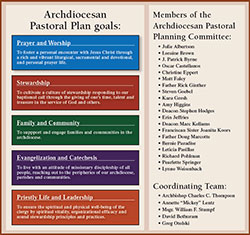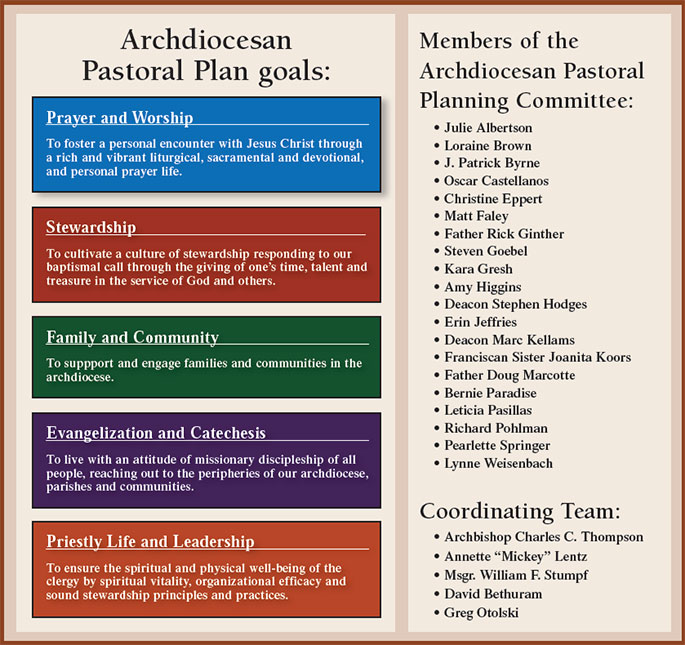New archdiocesan pastoral plan ‘provides a means for a shared vision’ for the future

Above are the goals and committee members for the new archdiocesan pastoral plan. Click on the image to see a larger version.
By Natalie Hoefer
On Feb. 19, Archbishop Charles C. Thompson signed off on a new archdiocesan pastoral plan that will guide the vision and focus of the Church in central and southern Indiana for the next three to five years.
“The advantages of a pastoral plan are provide a means for a shared vision and coordinated, intentional effort of evangelization and catechesis throughout the archdiocese,” he explains.
“At any given time in salvation history, there are particular goals or objectives that need to be addressed. Having a plan should also help us work together rather than in contrast or isolation as a local Church throughout central and southern Indiana.”
The plan was approved after several years of assessment, research and input by a team of 25 members from around the archdiocese. It addresses five critical areas: prayer and worship; stewardship; family and community; evangelization and catechesis; and priestly life and leadership.
Here is a look at those areas and goals, the team that formulated them and how these objectives will play out in the lives of the faithful across the archdiocese.
‘The Holy Spirit was really with us’
During the interim between the appointment of Cardinal Joseph W. Tobin to lead the Newark, N.J., Archdiocese and the installation of Archbishop Thompson in July of 2017, surveys and assessments were conducted throughout the archdiocese with an eye toward creating a new pastoral plan.
The archbishop took a year or so to become familiar with the parishes and flock in his fold. By the fall of 2018, he was ready to address the task of creating an archdiocesan pastoral plan.
The first step was to create a team to review the results and develop a plan.
“We invited people from all walks of life around the archdiocese—lay people, priests, religious, people who work for the archdiocese, different ethnicities, different ages,” says archdiocesan Chancellor Annette “Mickey” Lentz, who coordinated the effort.
“They were a fantastic team. You never know if a group is going to gel, but this team worked so well together. The Holy Spirit was really with us.”
Their first task was to read “The Joy of the Gospel,” Pope Francis’ 2013 apostolic exhortation. The document was chosen for its “articulation of his teaching on the proclamation of the Gospel in our current age,” says Msgr. William F. Stumpf, archdiocesan vicar general, who was also involved in the project. “We believed the archdiocesan pastoral plan needed to be rooted in the prominent and significant teaching of this document.”
Team member Oscar Castellanos, director of the archdiocesan Office of Intercultural Ministry, appreciates the exhortation’s focus on new evangelization.
“It became a source in choosing some of the primary language used in the pastoral plan,” he says, “words like ‘missionary disciples,’ ‘encounter with Jesus,’ ‘pastoral conversion,’ plus the rights of women and the social dimension of evangelization, among others.”
The team then met every six to eight weeks. They reviewed the former pastoral plan and the 2017 assessments, researched, conducted interviews, sought input and discussed their findings. They then discerned five goals (see below) and created four to seven objectives per goal.
After nearly 18 months of work, Lentz says the team was “hope-filled and felt good” about the plan Archbishop Thompson approved.
A plan ‘not meant for the shelf’
The archbishop says it is his hope “that the implementation of this plan will enhance our Catholic identity, mission and presence throughout the archdiocese.
“There is so much goodness, beauty and truth about being Catholic that seems to get lost amid the media focus on the scandals created by a few within and outside the Church.”
Father Rick Ginther, pastor of Our Lady of Lourdes Parish in Indianapolis, was on the planning team. He sees the effects of the scandals through the “anxiety our people have for the future—will the Church be there for us, how will it be there for us, who is going to lead us, and how will we bring that about together?
“I hope [this plan] will reassure them. I hope it will challenge them. I hope it will cause them to seek greater engagement in living out our shared faith.”
The priest says the pastoral plan “is not meant for the shelf.” Rather, he says, it is designed to be “enacted through the various secretariats of the archdiocese, by pastors, associate pastors, parish life coordinators, pastoral associates—but more so to be enacted in the very reality of our parishes, the people of God.”
Planning team member Christine Eppert of All Saints Parish in Dearborn County appreciates the pastoral plan’s focus on the family, through which she sees the plan being brought to life in the archdiocese.
“I see the family as the ‘front lines’ of the spiritual battle,” she says. “I am excited that the role of parents and families are called out clearly in the pastoral plan … through specific goals around devotional and family life that, if embraced and through cooperation with God’s grace, could radically change our faithful, one believer at a time.”
Her fellow team member, Patrick Byrne of St. Mary-of-the-Knobs Parish in Floyd County, also notes that the plan “is for all ages. ...
“It focuses on helping to develop a deeper personal encounter with Jesus Christ, being better stewards of our resources, supporting and engaging families and communities, spreading the joy of the Gospel to all, and addressing the ways to ensure the spiritual and physical well-being of our clergy.”
Existing with ‘eye of faith and hope in salvation’
The archdiocesan pastoral plan has been passed on to those responsible for developing action steps to implement the plan’s goals. Lentz says they will consider strategies, timelines, costs and ownership to take the plan from paper to reality.
“My hope is that we’ll be able to promulgate the plan in summer or early fall,” she says.
When the plan is released, it will be posted on the archdiocese’s website and published in The Criterion.
In the meantime, Archbishop Thompson offers a reminder of the overarching purpose of the Church that should drive every action by Catholics and archdiocesan entities in central and southern Indiana:
“Our ministries and services, while providing care and outreach to the spiritual and corporal needs of individuals as well as communities—families, parishes, schools, marginalized groups, etc.—ultimately exist with the eye of faith and hope in salvation of souls,” he says. “Together, through a common rootedness in word, sacrament and service, we carry on the mission of Jesus Christ as entrusted to the Church.
“We need to be intentional about proclaiming the Good News of Jesus Christ, drawing ever closer to him and providing a credible witness that leads others to a personal encounter with our Savior.” †
Click on the image below for a larger version:

Correction: Sue Weber, assistant facilitator of the Archdiocesan Pastoral Plan process and committee, was omitted from the list originally published above. †

